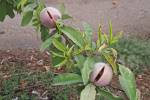Transplants available at orchard
This Saturday from 8 a.m. to noon, we will again have a wide selection of transplants available for local gardeners at University of Nevada Cooperative Extension Master Gardener Orchard near the intersection of Horse Drive and North Decatur Boulevard in North Las Vegas. These will be focused on summer gardening. They will be small so they should transplant into the garden easily and root quickly. They are priced inexpensively so you can buy and share some with your neighbors as well. For more information on what is available and how to get to the orchard, call the master gardener help line at 257-5555 no later than Friday morning.
Q: Over the last six seasons I have attempted to grow tomatoes here in North Las Vegas. Each season the plants themselves appear to be very healthy and large. However, they never produce tomatoes. I plant the tomato plants in mid-March in a large bed, 2 feet deep and filled with Miracle-Gro plant soil. I water the plants every morning. And once per week I spray the plants with Miracle-Gro fertilizer. I also provide sufficient shade for the plants. On one occasion, a plant did produce blooms, but they soon fell off the plant.
A: First what you did right. You prepared the soil, you fertilized the plants and you provided some shade. Now let's talk about what might have happened.
Several reasons might explain the lack of flowers and fruit production on tomato. First of all, if the soil was too heavily amended and the plants fertilized too often, it is possible you will see all vine and few flowers. I am not worried about the soil preparation you did as much as I am about the weekly applications of fertilizer. That is too often.
Amend the soil and fertilize when they are put into the ground and then don't fertilize until you see fruit set. Then fertilize lightly but frequently, perhaps four weeks apart.
It is also possible that if the shade is too dense, you will see no flowers produced and all vine, which will be spindly and the growth appear "stretched." You should not have more than about 30 to 40 percent shade. When shade is provided you should also reduce the fertilizer amounts. These are probably my two best guesses at your predicament.
Tomatoes need bees so make sure that pollinators are present and can get to the plants. Be sure you plant varieties of tomatoes that have a history of good production here. Some of these might include Early Girl, Champion, Jet Star and Patio.
Cherry and yellow pear tomatoes nearly always do well here, even with inexperienced gardeners, and are reliable in our climate.
Remember that when temperatures get hot this summer, the flowers that require pollination will not set but the fruit on the vine will continue to develop. Once that fruit is harvested you will hit a dry spell in fruit production until the weather cools down in the late summer. You can either pull them out and replant or cut them back and regrow the same ones.
Q: We have purchased a multibranched Wilson olive and were wondering how to stake it. We live in an area that has a very strong west-to-east wind flow, high wind gusts and the tree will be planted on a mound about 3 feet higher than the rest of the yard. Also we live in Las Vegas.
A: Wilson olive, or Wilsonii olive, is commonly planted as a fruitless olive tree. Remember that when we stake, normally we try to immobilize the rootball in the soil to speed rooting into the surrounding soil. Sometimes staking is required to prevent damage, but this is usually seldom. Staking should be minimal, enough to keep the trunk from snapping or cracking during strong winds but still allow the limbs movement from wind.
Tree growth is both in length and in girth or diameter. Side to side movement of stems contributes to increased limb girth or diameter. Restricting this side to side movement allows for growth in length but severely limits growth in girth.
Growth in girth gives stems the strength to stand upright without support. Plants that are not allowed to move in the wind and kept rigid for long periods of time will develop little girth.
The important point on staking to remember is to immobilize the root system by immobilizing the trunk or trunks while still giving them a chance to move and sway in the wind. Movement due to wind, as long as it isn't so excessive that the stem breaks or cracks, strengthens the stem.
Stakes should be about the same diameter as the limbs you are supporting. The stakes should be driven solidly into undug soil , not just the soil in the planting hole. The stake, or stakes if you need more than one, should be tied as low on the tree as possible while still immobilizing the rootball in the backfill of the hole.
If the tree does not need to be staked, then don't stake it.
Prune the tree to thin out the canopy to reduce the chance of "sail" effect. The sail effect is what moves the rootball in the planting hole and interferes with how fast the tree will root into the surrounding soil. You should be able to see through the canopy easily when you are done. If you can see through it easily, the wind will move through it more easily and the sail effect will be reduced.
Q: Is now a good time to trim my Chilean mesquite trees? They have almost completely shed their leaves from last summer and what I see are a lot of spindly limbs that look like they should be trimmed. Or, shall I wait until fall?
A: Chilean mesquite is a variety of mesquite tree that is supposed to be thornless. It is not too late to trim them but you better do it quick. Yes, even though mesquite is supposed to be evergreen, when it is cold enough it does drop its leaves. Many mesquites are what is termed a riparian plant. It responds quickly and dramatically to water when it is available.
Watering frequently and deeply will cause the tree to grow quickly and put on a lot of new growth. It also will grow quickly in response to pruning so be careful in your watering after your pruning or you will put on all the growth you removed in a very short time.
Q: Can you advise me on a good fertilizer for my Mondell pine trees which are approximately five years old?
A: Any balanced fertilizer, such as a 16-16-16 or 10-10-10 or 8-8-8, or any fertilizer that looks approximately like these numbers would be good. Actually, most lawn fertilizers will be fine as well; just make sure there are no pesticides mixed in with the fertilizer.
Nitrogen, the first number, is most important to nonflowering trees like pines and will be the most important to apply. Keep the fertilizer away from the trunk and apply it near the tree's water source, a few inches below ground. Another method is to use fertilizer stakes, which are neat, clean and you don't have to worry about opened bags of fertilizer.
Bob Morris is an associate professor with the University of Nevada Cooperative Extension. Direct gardening questions to the master gardener hot line at 257-5555 or contact Morris by e-mail at morrisr@unce.unr.edu.























